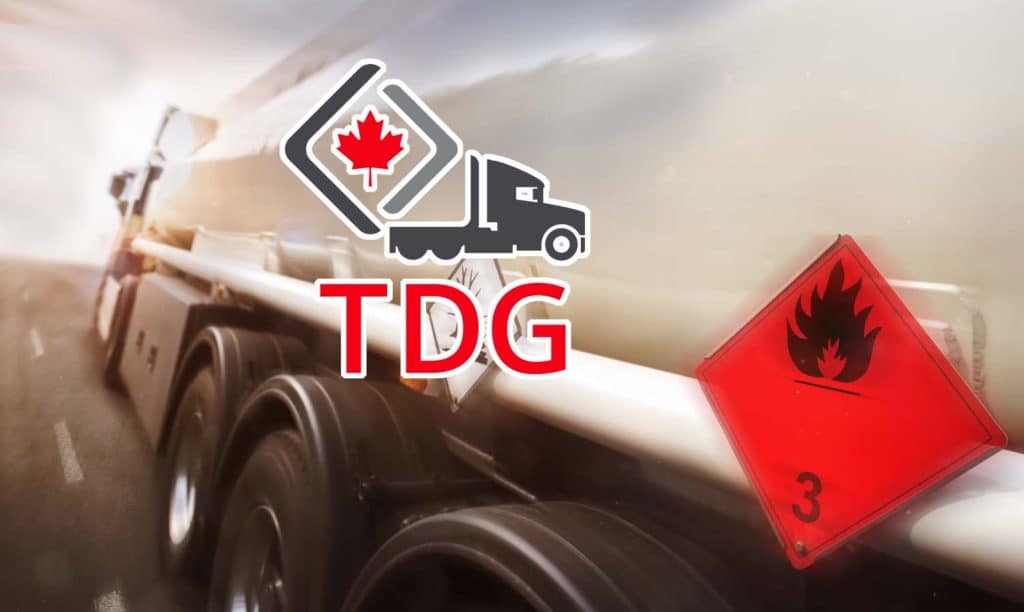
Kevin’s Blog / What is TDG?
TDG can mean a couple of things.
It can be a simple acronym for the Transportation of Dangerous Goods Act and Regulations, such as: ”Make sure you follow TDG!”.
In a workplace, it often refers to a training certification or course, more like: “Do you have TDG?”
TDG Basics
The Transportation of Dangerous Goods Act and Regulations is Canadian legislation, and only applies in Canada. The comparable US legislation is US Dept of Transportation, 49 CFR (Code of Federal Regulations, Title 49).
Because of the volume of trade between Canada & the US, both pieces of legislation were framed with similar requirements for handling & transporting dangerous goods. This enabled reciprocity agreements to be made to accept both regulations as more or less compliant with each other.
At work, TDG certification is a necessity for anyone involved with handling & transporting dangerous goods. This includes actual handlers, such as truck drivers & warehouse operators (fork lift, crane, manual labour), as well as all document preparers and handlers, such as shippers and dispatchers.
The working TDG process is based on the TDG Classifications, TDG Shipping Document & TDG Regulation Schedules.
TDG Classifications
The TDG Classification System has Primary Classes & Divisions, as well as Subsidiary Classes & Divisions. Basically, Classes are based on the characteristics of the substance, while Divisions reflect the degree of hazard posed by the substance.
TDG Classes & Divisions
Class 1: Explosives

- Division 1: Substances & Articles that have a Mass Explosion Hazard
- Division 2: Substances & Articles that have a Projection Hazard but not a Mass Explosion Hazard
- Division 3: Substances & Articles that have a Fire Hazard and either a Minor Blast Hazard or a Minor Projection Hazard, or both
- Division 4: Substances & Articles that Present No Significant Hazard or only a small hazard in the event of ignition or initiation during transport, with any effects largely confined to the package
- Division 5: Very Insensitive Substances that have a Mass Explosion Hazard
- Division 6: Extremely Insensitive Articles that do not have a Mass Explosion Hazard
Class 2: Gases

Class 2 Safety Marks
- Division 1: Flammable Gases
- Division 2: Non-Flammable, Non-Toxic Gases
- Division 3: Toxic Gases
- Division 4: Oxidizing Gases
Class 3: Flammable Liquids (no Divisions)

Class 3 Safety Mark
Class 4: Flammable Solids, and Substances liable to Spontaneous Combustion

Class 4 Safety Marks
- Division 1: Flammable solids
- Division 2: Substances Liable to Spontaneous Combustion
- Division 3: Substances that, In Contact With Water, Emit Flammable Gases
Class 5: Oxidizing Substances & Organic Peroxides

Class 5 Safety Marks
- Division 1: Oxidizing Substances
- Division 2: Organic Peroxides
Class 6: Toxic & Infectious Substances
- Division 1: Toxic Substances
- Division 2: Infectious Substances

Class 6 Safety Marks
Class 7: Radioactive Materials (no Divisions)

Class 7 Safety Marks
Class 8: Corrosives (no Divisions)

Class 8 Safety Mark
Class 9: Miscellaneous Products, Substances or Organisms (no Divisions)

Class 9 Safety Mark
TDG Shipping Document
The TDG Shipping Document must contain certain information & must always accompany the shipment. It provides information about the shipment’s dangerous goods to anyone who may need it the, especially in an emergency.
All Dangerous Goods are identified by UN Number, Shipping Name, Primary Class, Subsidiary Class, Packing Group, Compatibility Group, & Infectious Substance category.
TDG Regulation Schedules
The TDG Schedules are for for reference & are used when creating the Shipping Document. The Schedules are available online.
This blog only scratches the surface of TDG. Completion of an accredited training course is needed to acquire a TDG certification card. If you need TDG and want to get ahead of the game, Contendo offers a full TDG Awareness training package.

Contact us if you need help; and stay safe!
Go to https://contendo.ca
Kevin Fox is a power engineer & senior technical writer at Contendo. He has written process education programs for industrial clients and students since 2009.




